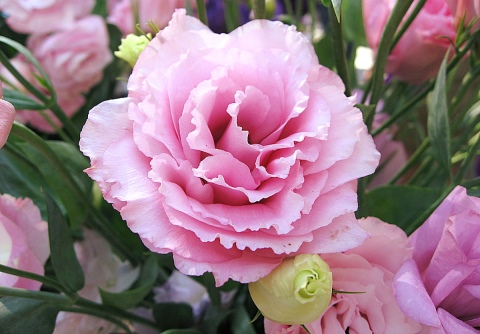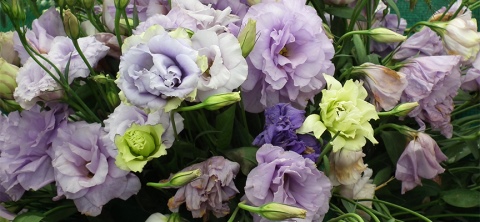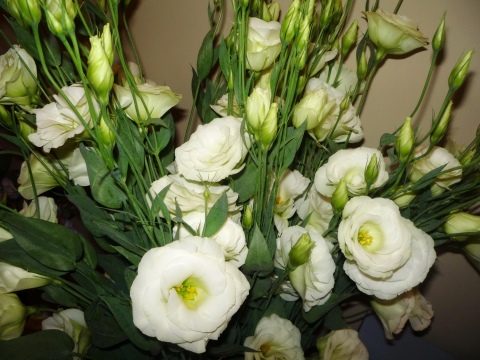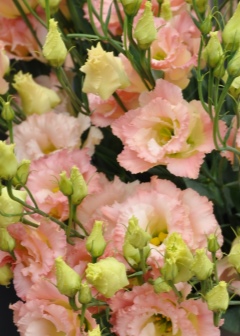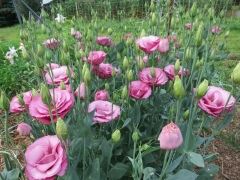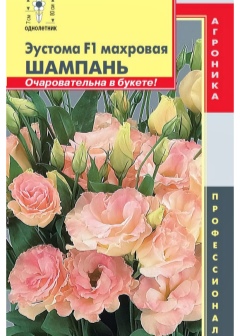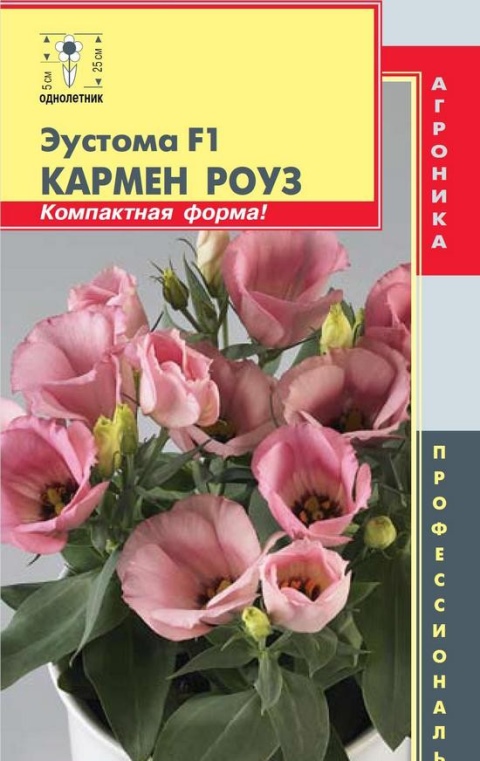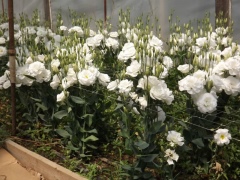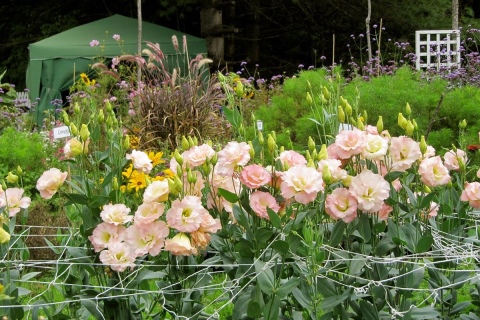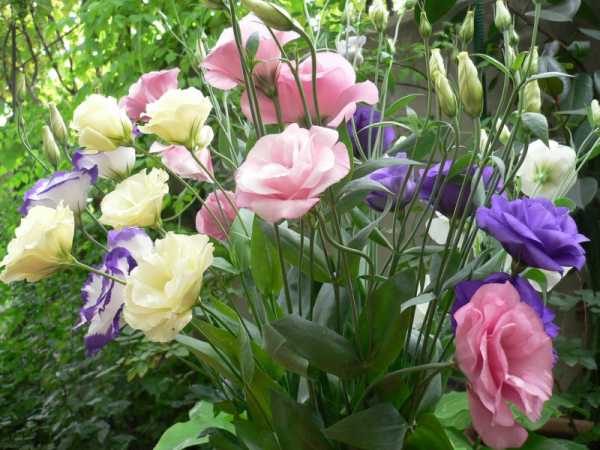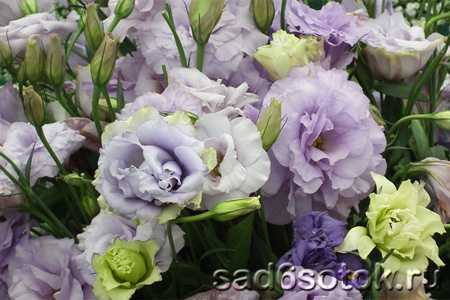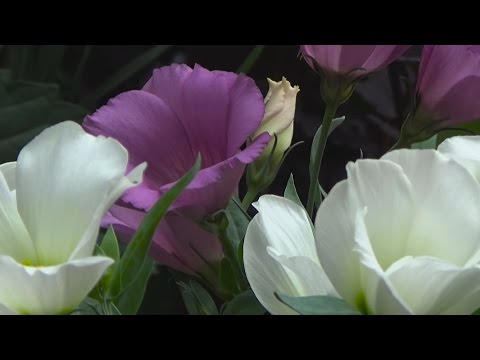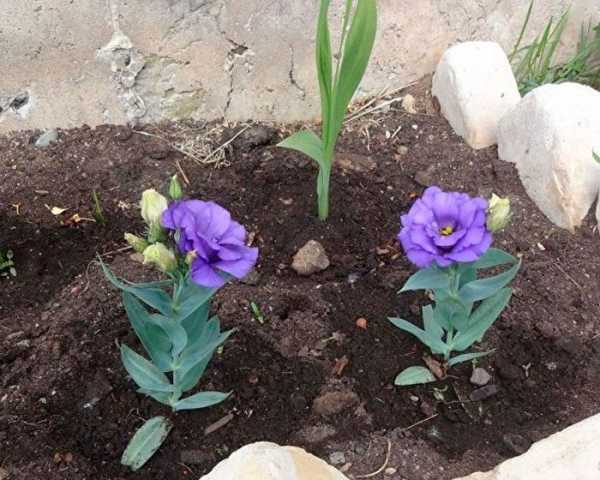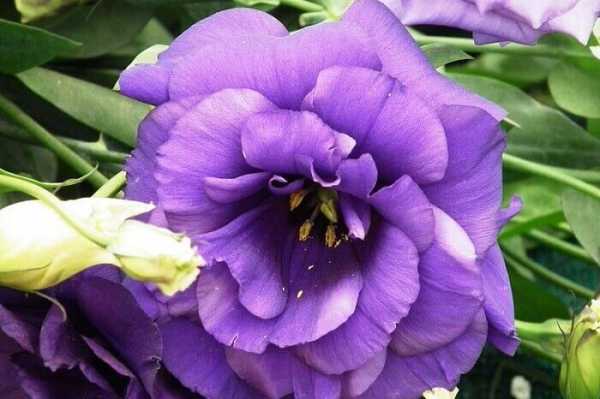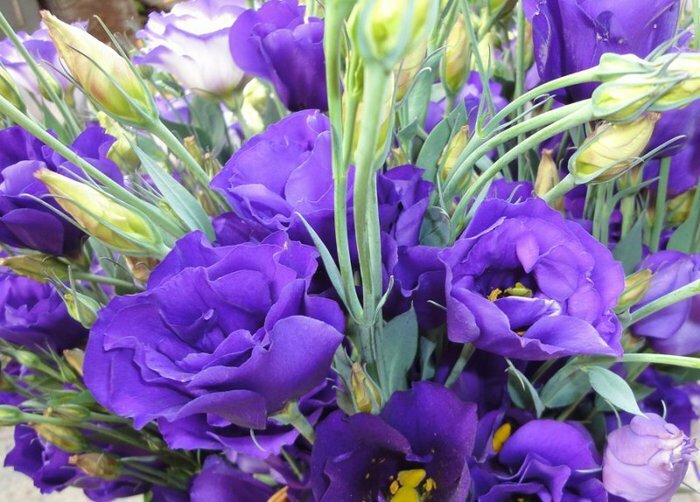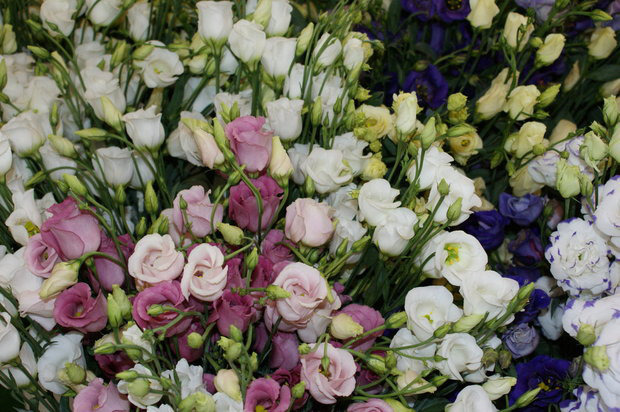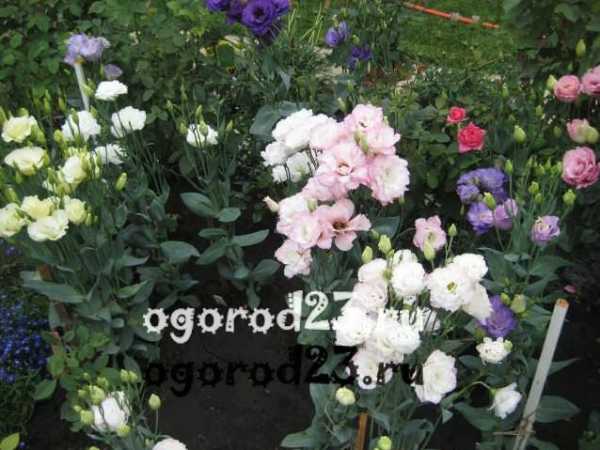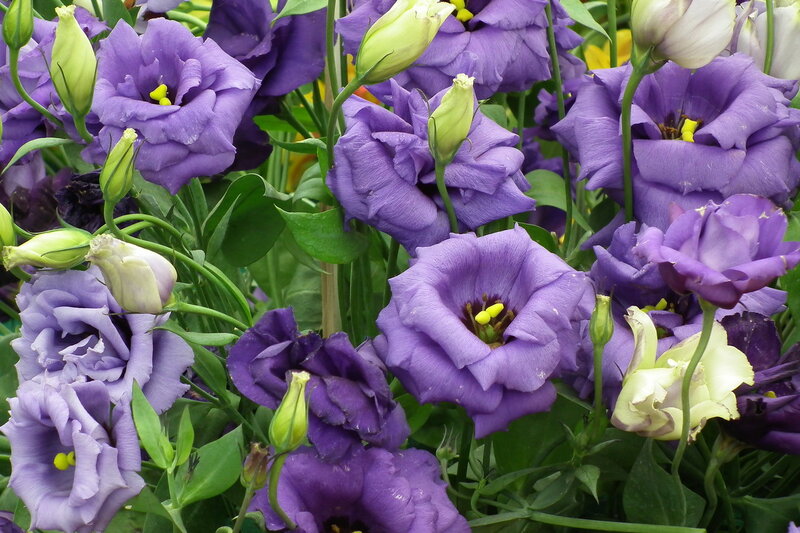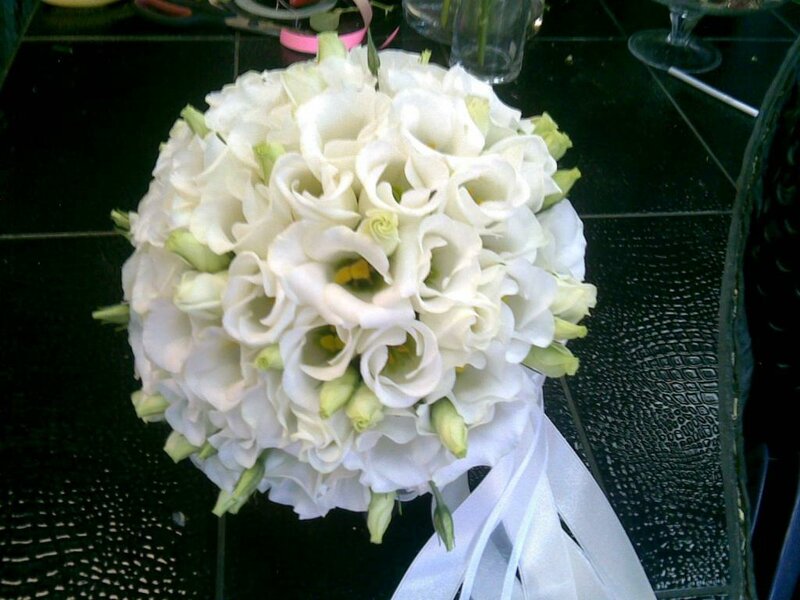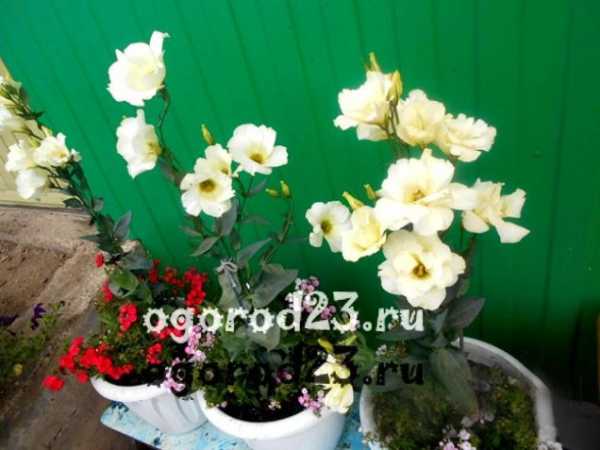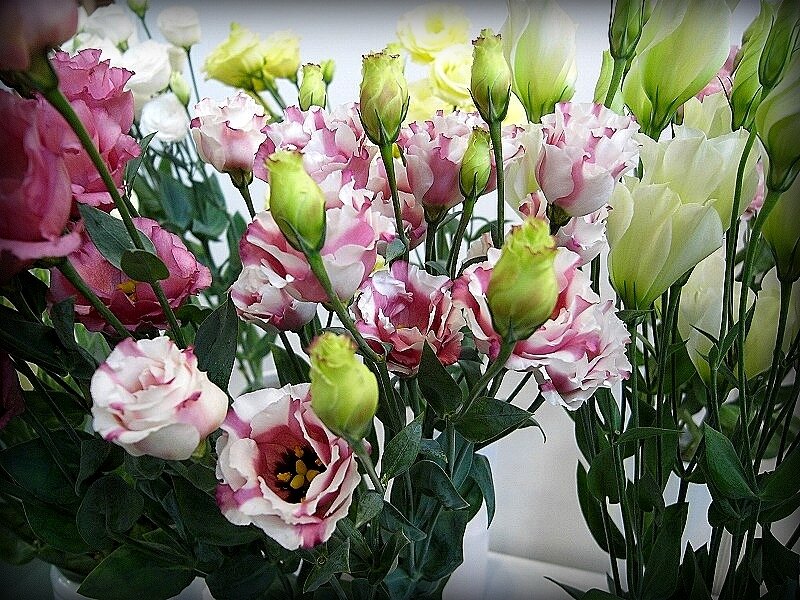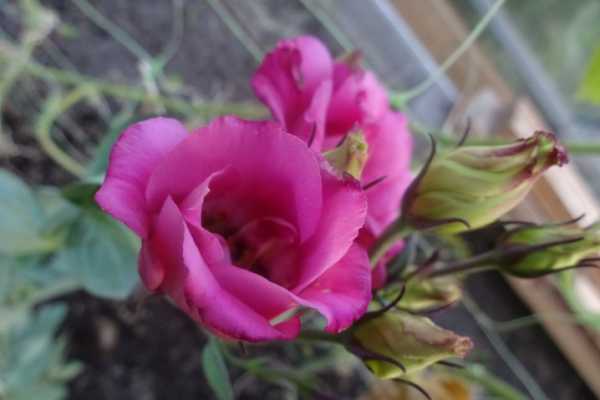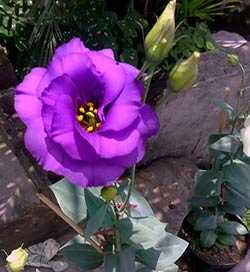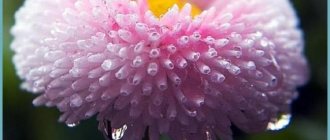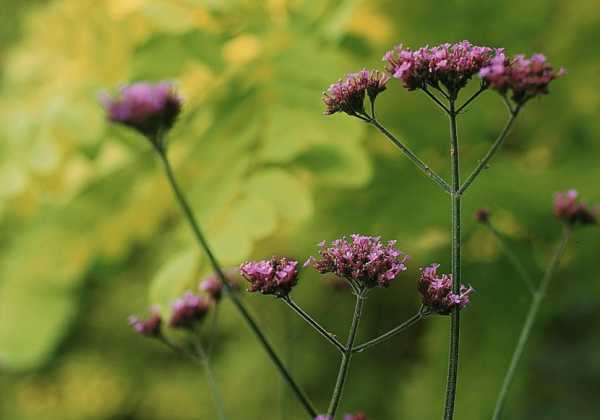Growing eustoma.
Eustoma prefers sunny places with well-filled soil with humus. In order for it to fully reveal its beauty, it is necessary to feed with mineral fertilizers that contain NPK with trace elements, systematic watering and spraying.
In protected ground conditions, eustoma needs a warm content with humid air and periodic ventilation.
Reproduction of eustoma.
Since eustoma is difficult to tolerate a violation of the root system, reproduction by dividing the bush is considered possible, but ineffective. Cuttings do not germinate at all. Lisianthus is usually propagated by seed. Eustoma seeds are very small and therefore, for sowing convenience, it is best to purchase them in the form of granules. The seeds are sown on top of light sterile soil or in peat tablets. So that when watering the seeds are not washed away with water, slightly compact the soil before sowing. Germinate in light, but protected from direct sunlight. Cover crops with foil, put in a bright place with an air temperature of 21-25 ° C during the day and 18-20 ° C at night. The film must be removed several times a day to remove condensation and ventilate. Seedlings appear in 10-12 days. They develop very slowly at first.
When 2-3 true leaves appear, the seedlings carefully, so as not to damage the root system, dive into separate pots, 3 pieces each, immersed in the ground to the lower leaves. We create a greenhouse effect. At the beginning of March, the grown plants are transplanted into larger pots by transshipment. When 3-4 pairs of true leaves are formed, pinch the top. Pinching is done for stronger branching. Top dressing can be started 10-14 days after the pick. Eustoma is planted in the ground when the threat of frost has passed.
A place for growing in the garden is chosen light, protected from drafts, with light permeable soil. Planting is carried out in the evening or in cloudy weather by transshipment at a distance of 15-20 cm between plants. At first, the planted plants should be shaded from the bright midday sun. To do this, cover each plant with plastic bottles or glass jars for 2-3 weeks.
If the young plants were at temperatures above 28 ° C, then the flowering period will shift and they will develop as biennials: in the first year, a rosette of leaves will form, and flowering will begin in the second year.
Lisianthus seedlings should be sprayed with phytosporin solution once a week. This will prevent black leg disease from developing. For good development of seedlings, spraying with growth stimulants is used.
The beginning of eustoma flowering depends on the time of sowing the seeds. If sowing is done in December, then flowering will begin in July, respectively, January crops will give flowers in August.
In autumn, before the onset of frost, eustoma can be dug up and brought into the house and grown as a houseplant. In the spring, plant again in open ground. In winter, Lisianthus should be kept cool at 10-15 ° C. For this, winter gardens or insulated loggias will serve as a good place.
Growing eustoma as a pot culture.
Growing eustoma in pots is not easy as it needs fresh air and bright light.
It is better to give her a place in the west or east window with the possibility of regular ventilation.
When planting, pour drainage on the bottom of the pot. Add fine river sand and pieces of charcoal to light peat nutrient soil. You can use ready-made soil mixture for Saintpaulias.
Watering is carried out with warm water when the topsoil dries up. Waterlogging or drying out of the earthy clod is detrimental to plants.Water only on top of the pot. Spraying is excluded. It can lead to leaf disease.
Liquid complex fertilizer is used for feeding eustoma. It is diluted with 10-15 ml per 10 liters of water. Withered flowers should be cut off in time. When the potted eustoma has completely bloomed, cut off the stems, leaving 2-3 internodes on them and transfer them to storage in a room with a temperature of + 10-15 ° C. During the dormant period of the eustoma, watering should be reduced to a minimum, and lumps should be excluded. In the spring, when new shoots appear, transplant the plants into fresh soil and resume normal care. When growing eustoma in indoor conditions, periodic insecticide treatments for spider mites, thrips and whiteflies are required. Possible diseases of mycosis, fusarium and gray rot.
Every year, more and more varieties of eustoma appear with various forms of flowers of various colors. Many hybrids have been developed. Low-growing varieties (up to 40 cm high) of Lisianthus are intended for growing as indoor or balcony varieties, varieties with a height above 40 cm are grown in the garden or greenhouses for cutting.
Planting and caring for eustoma seeds in open soil at home
It makes sense to plant eustoma in open ground conditions in the following ways:
- Growing eustoma from seeds immediately, in the open field;
- Pre-cultivation in home pots, followed by planting in open ground.
Eustoma seeds are distinguished by high germination, which makes them attractive for planting in open ground at home. A feature of planting eustoma is the fact that the soil must be fertilized and properly prepared at home before planting. Namely, you need to create a mixture for planting, consisting of black soil and coarse sand. For fertilization, you can add humus, as well as a small amount of lime.
When planting and nursing outdoors, take into account the temperature at which shoots begin. It is necessary to maintain the temperature under the film in the region of 20-25 degrees Celsius, and in winter at least 10 degrees. Already the first shoots of sprouts may appear a month after planting.
Lysiatus or eustoma can be planted in open field conditions, both for one season, and for several. When planting and leaving, you need to take into account the germination time of the seeds of the "Irish rose". The timing is as follows: the eustoma plant begins its flowering approximately four months after the emergence of the plant. Therefore, you need to plan the planting period, namely, so that flowering occurs in the summer, you need to start planting seeds in the winter, choosing February for this. Many gardeners who grow flowers for sale plant eustoma at home in all seasons.
Do not forget about additional heating of the earth and warming of planting seeds with a film for the winter-spring period. But all the same, for planting seeds directly in open ground, areas with a southern and hot climate are suitable, where in winter the temperature does not drop to too low limits, or you can plant seeds at home.

Eustoma care
Growing room eustoma has its own characteristics, depending on whether we want to get the flowering of an annual plant, with its subsequent destruction, or we will try to leave it for the second year. Usually, flower growers follow the first path, it is much easier.
Watering eustoma
The soil in the pot should always be moist, in the same time, without stagnant water. Water with soft water, preferably even distilled water, or at least settled, boiled. The temperature of the irrigation water should never be lower than the ambient temperature, preferably a few degrees warmer.
Important! After abundant watering, be sure to pour out excess water from the pan, otherwise the roots of the plant will rot
Top dressing
They should be fairly regular as the roots of the plant are small.In the spring, while the leaf mass is growing, you can add organic matter or mineral fertilizers with a high nitrogen content.
With the beginning of the formation of buds, they begin to feed with mineral fertilizers intended for flowering plants. If you prepare the mixture yourself, you should increase the proportion of phosphorus and potassium. During the active growing season, feeding is carried out 3-4 times a month.
Post-flowering care
If, nevertheless, a decision is made to preserve eustoma for the winter, the following measures should be taken.
- Cut off the stems tightly, leaving no more than a third of the leaves on them;
- Take the eustoma to a place where it will be pretty cold all winter, around + 10 ° C.
- Provide, at the same time, good lighting, additional lighting during the shortest winter days;
- Watering rarely, once twice a month, making sure that the earthy clod does not dry out completely.
- Exclude top dressing during the rest period.
Noticing that new shoots begin to grow on the stems (usually this happens in the second half of February), the plant is transferred to a warm room, watering and feeding is resumed. At the same time, the plant is transplanted into new soil.
Transfer and soil characteristics
Eustoma painfully perceives the transplant, therefore, in fact, it must be carried out in the form of a transshipment, protecting the existing earth clod and roots as much as possible. The new pot should not be much larger than the previous one. Choose the soil that suits our plant: light, loose, able to easily pass water and be saturated with air. Her reaction should be either neutral or slightly acidic. Many amateurs claim that eustoma grows well on a ready-made soil mixture for Saintpaulias. If the decision is made to prepare the substrate yourself, you need to take the top layer of earth from under deciduous trees, peat and sand, mixing them in equal proportions. Make sure to arrange good drainage at the bottom.
Important! In no way should you cut the roots of the plant, divide the rhizome. Eustoma is unlikely to survive such procedures
How to plant?
After you have selected the appropriate place for planting eustoma, and it should be free of drafts and wind, choose a cloudy day, in the late afternoon. It is necessary to land in late spring or early summer, when the nights are warm and the earth is warmed up. Before planting a seedling from a container into open ground, prepare a depression in the ground, no larger than the pot in which the seedling was located. Gently remove the seedling from the pot, just turn it upside down so that, without damaging the root system, immediately plant it in a hole in the place with a clod of earth. Sprinkle lightly with earth and cover with a transparent hood to avoid drafts and sudden drops in temperature.
An interval of 20-25 cm between seedlings is recommended. It does not matter how the plant is planted, in the form of a seed or a seedling, it will still bloom in the first year. Flowering lasts about two months, from mid-summer to autumn. At this time, you can periodically cut the stems with flowers, since new ones will grow during the abundant flowering anyway. The plant should not be planted near metal fences, because when they are heated from the sun, the flower can get burned.
Growing eustoma from seeds at home
|
You can grow lisianthus yourself from purchased seeds. It is unlikely that it will be possible to collect your own, since, as a rule, hybrids that do not give seeds after flowering go on sale. Independent growing eustoma from seeds the process is long and time consuming, but many growers successfully cope with it. Lisianthus seeds are small, so they are sold in the form of granules. In addition, the special composition from which the granules are made improves germination. In general, eustoma seeds do not germinate very amicably. The germination rate of 60% is considered good. Sowing seeds is carried out from January to March in a light soil that is well permeable to air and moisture.At home, you can make it from garden soil, peat or vermiculite and sand in equal amounts. The soil is well soaked, the seeds are poured from above, without covering. Slightly pressed in and sprayed with a spray bottle. Cover with a transparent film (bag) and put in a warm (20-25 degrees) and bright place. If sowing is carried out in January-February, additional illumination will not be superfluous, ideally when the seeds receive light for 12-14 hours a day. It is also good if it is possible to transfer the container with planted seeds to a cool room with a temperature of 14-17 degrees at night. These are the recommendations of experts, but often, sharing their experience, flower growers say that they manage to grow eustoma seedlings without additional lighting and nightly lowering the temperature. It was noticed that with a later planting, in March-April, the plants give flower arrows earlier, but the rosette of leaves is formed worse and the bushes are less lush. The seedlings should be ventilated about once a day. The soil must be kept moist by spraying. Seedlings that look like tiny dots appear after about 2 weeks. After that, watering is significantly reduced and, if possible, the plants are transferred to a cool (14-17 degrees) place. Further, the seedlings grow slowly, only after 1.5 months, when 2-3 pairs of real leaves appear, a pick can be carried out. In this case, the eustomas are placed in separate small pots. For good branching, the tops of the seedlings are pinched when 3-4 pairs of leaves are formed on them, and after 3 months they, together with a lump of earth, are transplanted to a permanent place in a garden or in a separate pot for home keeping. You can land in the garden after the last frost, in the middle lane this is the end of May - beginning of June. |
How to take care of it properly?
There are no particular difficulties in caring for this plant. But, nevertheless, it needs timely watering, feeding, protection from diseases and pests.
Watering
The plant categorically does not tolerate stagnant moisture and periods of drought. Lisianthus sheds buds from drying out of the soil. It will be optimal to maintain moderate humidity; it is necessary to irrigate as the top layer of the earth dries up with rain or settled water.
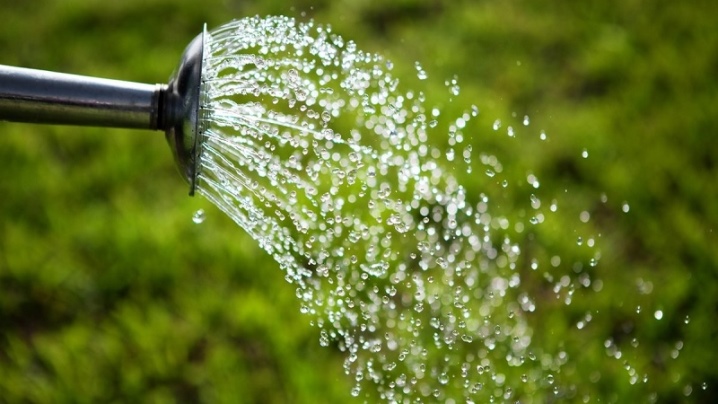
Fertilizer
Since the flowering of eustema begins in mid-summer, it is during this period that it is necessary to feed the plant with fertilizers. They should have a high content of potassium and phosphorus, a small amount of nitrogen. The most suitable for this are the preparations "Plantafol budding", "Kemira lux". They have a beneficial effect on flowering, making it luxurious and long-lasting. The only rule: the concentration of the fertilizing prescribed in the instructions should be slightly less.

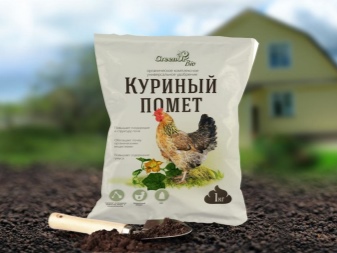
Pruning
Pruning faded inflorescences is not only a prerequisite for maintaining decorativeness, but also a measure to stimulate the growth of new flowers. Do not be afraid to cut off shoots to compose a bouquet, new ones will ripen in about a month.
Pinching is important for the plant. It is carried out between 3-4 pairs of leaves. Thanks to this, they grow, the flowers become lush, their number increases to 20 pieces.


Seed collection and wintering
After the end of flowering, seed pods are formed. They ripen only after pollination of the inflorescence. If the plant is on the street, then the bees are engaged in this, and if the flower lives in the house, then pollination can be done with a brush. The seeds are harvested in dry weather, when there has been no rain for more than a week. The collected seeds have good germination. They are well dried in room conditions and stored until spring.
After collecting the seeds, the plant can be prepared for winter. Around September, when the weather is still warm, the stems of the plant are cut, leaving only 3-4 buds, and transplanted into a pot.The flower does not tolerate a transplant, it needs adaptation, it is at this time that additional care must be provided to the plant. The pot is transferred to a room where the temperature should be 10-15 degrees. Provide a gradual decrease in illumination, maintain the humidity in the room. Watering is gradually reduced to a minimum, moisturizing is carried out every 10-14 days. While the plant hibernates, it is dormant and does not grow, its vital functions slow down. Due to frequent transplants, he lives in our latitudes for no more than 5 years. Every year and with every transplant, the flowering is not so abundant, the size of the flowers decreases.


Diseases and pests
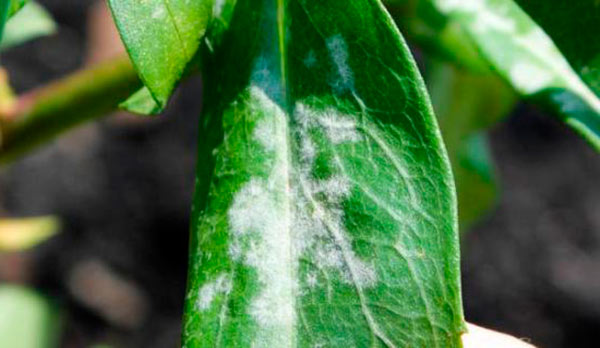
Despite the fact that this plant is very demanding for planting and care, serious diseases and pests are not terrible for the "bitter flower". But nevertheless, eustoma can affect: various types of aphids; slugs; mushroom mosquitoes and others.
At the first symptoms of the above parasites, the flowers should be treated with appropriate preparations that can be purchased at the store.
If there is a regular waterlogging of the soil or the flowers are too tightly planted to each other, then gray rot or powdery mildew may appear. To prevent the appearance of these diseases, plants are treated with anti-fungal drugs for prevention.
Varieties and varieties of flowers with a photo
In total, there are about 60 species in the world. Their main differences in the appearance of each of them are shades of flowers and foliage, a variety of forms. The more popular varieties include the following:
Large-flowered Russell eustoma - this variety has a straight stem, buds resemble poppies in shape, petals with a smooth edge or with a fringe, bud shades may be different.
Eustoma Echo is the most suitable variety for use in bouquets. The height of the stem reaches 60 cm. The buds are found in different shades, of which there are about 11. These are both monochromatic and gradient varieties.
Lisianthus Aurora - the height of the plant can be 1.5 m. It begins to bloom early with double flowers of saturated pink, blue or white flowers.
Eustoma Flamenco - height up to 1.3 m. One of the highly decorative varieties. It is unpretentious to care for and has many buds on the stem.
Lisianthus White Large-flowered is another highly decorative variety. Cut flowers are often used to decorate festive interiors, as well as to make a bridal bouquet from it.

When to plant eustoma for seedlings
Eustoma is of great interest to both gardeners and indoor plant lovers. Eustoma flowers resemble rosebuds and can have a wide variety of colors: yellow, pink, red, etc. Depending on the variety, some varieties of flowers are used to create bouquets (tall varieties), others - to compose all kinds of compositions (undersized).
Recently, eustoma has become a rather popular flower, and this is not surprising, because the plant is very beautiful, albeit capricious in growing. If you want to grow eustoma from seeds and are not an experienced florist, then choose annual crops for planting. Remember, undersized crops are much less capricious in growing them in the house.
When to plant eustoma for seedlings
First of all, you need to focus on the weather conditions. For example, in central Russia, it is preferable to plant eustoma for seedlings in December-January, the latest is mid-February. The thing is that the plant begins to bloom at 17-18 weeks, and sometimes at 20, that is, it may take up to five months. Therefore, if you live in the Moscow region or in the nearby regions, then do not delay planting seedlings of these crops, otherwise you simply will not wait for flowering, since the autumn frosts will destroy the flowers.
How to grow eustoma seedlings
If you have already purchased eustoma seeds, then consider them.If they have a pelleted form, that is, several seeds are woven into a small ball at once, then you can be sure that their germination will be at a height (of course, if the seeds were stored correctly). First of all, get a special soil for this type of plant. If you have not found one, then do not despair, since the mixture can be prepared on your own. To do this, you need to mix ordinary flower soil and river sand in a 2: 1 ratio. Fill the seedling containers with the prepared mixture, spread the seeds and lightly sprinkle them. Moisten the soil liberally with a spray bottle with soft water, cover with plastic wrap and place the pots in a warm, bright place. Every 24 hours, remove the film for a couple of hours (this is required so that fungus does not appear on the soil), and then cover the container with it again. After about 14 days, the first shoots will appear, at this stage, watering must be reduced, and the temperature of the seedlings should be gradually reduced to + 18 degrees. As soon as the seedlings have more than five to six leaves, they can be transplanted into separate containers and fed with complex liquid fertilizers every 20 days. After three months, the formed plants must be transplanted either into large pots (this applies to low-growing crops), or into a greenhouse or garden.
How and when to plant eustoma
There is nothing difficult in planting eustoma, for this you need to carefully remove the ready-made seedlings from the pots together with an earthen lump and place it in specially dug holes in the beds or greenhouse in the garden. Sprinkle each plant with earth (at the base), gently crush the earth, water abundantly with water and, if required (the nights are rather cold), then cover the seedlings. The first top dressing can be applied a month after the transplant, the second - after another month.
.
Description
Eustoma is a perennial plant of the gentian family. She is also known as Lisianthus. America is considered the birthplace of the flower - North South, North South and Central.
Translated from Latin, eustoma means "lovely mouth", "beautiful mouth".
The plant is quite popular among flower growers. It can be grown both outdoors and at home. Eustoma and florists love. They use it to make bouquets, since cut flowers keep their fresh and attractive appearance for a long time.
The eustoma has strong and stately stems, which can reach a height of 1 m. Due to its good branching, even one branch looks like a full-fledged bouquet.
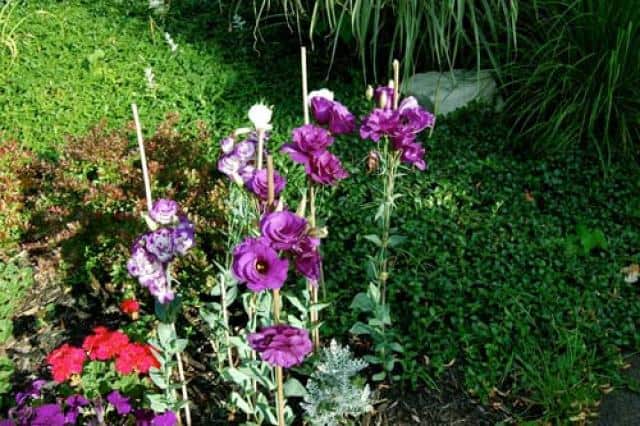
Up to 35 buds can grow on a branch. They dissolve in turn, replacing each other. The foliage of the plant has a gray-gray tint, matte texture, oval shape.
The plant's large flowers grow in the shape of a funnel, and the calyx grows up to 508 cm in diameter. The color can be monochromatic (white, purple, lilac, pink, lilac) or contrasting two-color (petals and edging along their edges are different). In terms of beauty, eustoma competes with roses.
The buds, which have opened only halfway, are very similar to the "queen of flowers", and when fully opened, they resemble poppies.
In the open field, eustoma usually grows for 2 years. In a pot at home, it will grow for about 4-5 years.
general information
The lifespan of indoor eustoma is short - up to 2 years. In the open ground of central Russia, it is grown as an annual crop. A beginner will cope with the cultivation of an annual. In the southern regions, the flower is cultivated as a perennial.

Eustoma - the queen of the garden
When cultivating eustoma in a summer cottage, cultivation and care in the open field will require experience from the grower. The slightest mistakes provoke the death of the flower.
When buying seeds, the package indicates what type of crop can be obtained: one-year / two-year. The biennial is preferred by greenhouse owners, as well as indoor flower lovers.When it is planned to grow a perennial eustoma on an unprotected flower garden, an annual option is suitable for planting.

Eustoma in a greenhouse
Lisianthus seeds resemble dust. During packaging, special substances are processed to stimulate plant growth. In addition, the granules are easier to plant.
The germination rate of its planting material is low. The quality is compensated by the quantity - 1 g of seeds contains more than 20,000 of them. In order not to appear dense thickets in the box, and to avoid thinning, dosage of the number of seeds is required.
To avoid problems with picking and removing excess sprouts, peat glasses are used.
Embedding of seed into the ground is not carried out, only scattering over the surface. They irrigate the ground with a spray bottle with a fine spray, otherwise the eustoma seeds will hide deep in the soil, seedlings will not appear.
If they are engaged in the cultivation of eustoma, planting and care will require:
- Selection of a suitable place: partial shade or shade.
- Avoiding the planting of Lisianthus in objects that reflect sunlight on it.
- The distance between seedlings is from 20 cm.
- Avoiding increased moisture and intense moisture. It is forbidden to plant a flower under a ledge of a roof or a drain groove, where water will stagnate when it rains.
- Moisture permeability of garden soil and neutral pH level. Wood ash, which is introduced into the holes, will regulate the acidity of the soil.
- Adding nitrophoska into the seedling holes or flower dressing from the store.
Container planting prolongs the life of Lisianthus and its flowering. Different dishes are appropriate for her: tubs, flowerpots.

Planting eustoma in containers
If it's warm outside, keep crops outdoors. The cold is approaching, it's time to bring flowers into the house. Flowering still lasts but becomes modest.
The eustoma rhizome allows the container technology to be preserved in winter. She will provide a planting in the spring on a flower garden with new shoots. The imperfection of the method lies in the weakening of flowering.
Interesting Facts
The elegant flowers of double varieties of eustoma resemble rose flowers, so the “folk” names of Irish, French, Japanese, Chinese, Mexican rose are firmly entrenched in it.
Its other name is "prairie bell", in nature it grows in Mexico, the American states of Texas, Colorado, Nebraska and in the northern part of South America.
.
- Growing and caring for eustoma
- Eustoma purple
- White eustoma flower
- Undersized eustoma
- Eustoma how to plant
- Growing eustoma from seeds
- Eustoma in the garden photo
- Cultivation of eustoma forum
- Sowing and growing eustoma
- How to grow an eustoma flower
- Eustoma varieties
- Terry eustoma
- Eustoma grows poorly
- Eustoma flower is
- Eustoma in the open field
- Growing an eustoma flower
Perennial eustoma, planting and care of seedlings
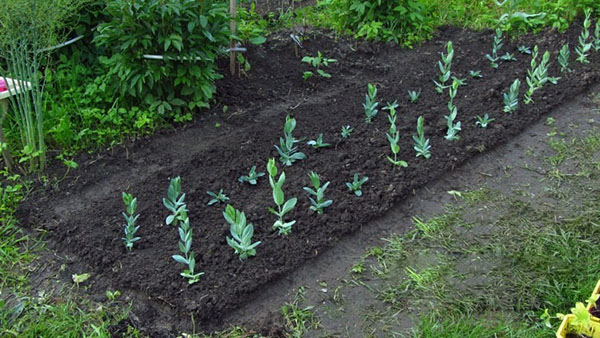 Growing eustoma requires efforts from the grower. This is a thermophilic plant that will grow and bloom well only under favorable conditions.
Growing eustoma requires efforts from the grower. This is a thermophilic plant that will grow and bloom well only under favorable conditions.
How to prolong eustoma flowering
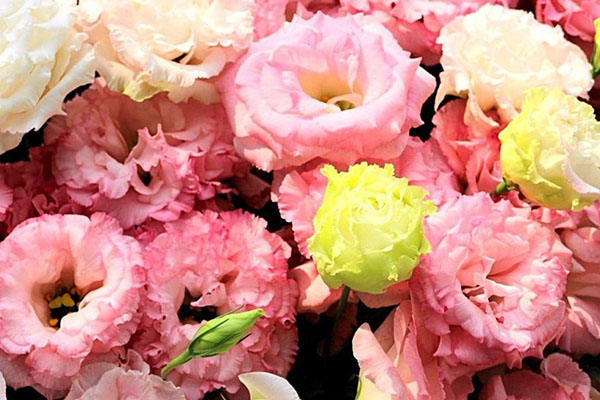
For breeding, 2 methods can be used, since perennial eustoma is not a bulbous culture:
But the latter method rarely gives a good result, since cuttings are difficult to accept. When propagated by seeds, the time to start flowering depends on when the planting was carried out. For flowering to begin in June, seeds must be planted in November. With late planting (in February), the eustoma will bloom in early September.
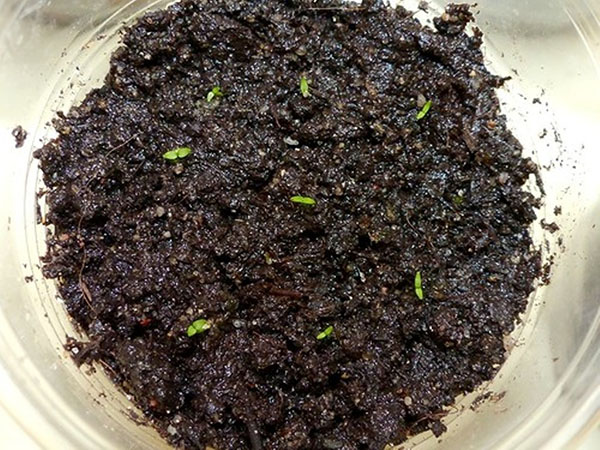 Container planting is capable of extending the life of flowers. Flowers planted in containers can be taken out into the street in the warm season, and in cold weather they can be brought into the room again. At the same time, the plant will continue to bloom, albeit less abundantly. The root system saved in this way can be used for the next year. But the bloom will not be as lush.
Container planting is capable of extending the life of flowers. Flowers planted in containers can be taken out into the street in the warm season, and in cold weather they can be brought into the room again. At the same time, the plant will continue to bloom, albeit less abundantly. The root system saved in this way can be used for the next year. But the bloom will not be as lush.
Planting and caring for perennial eustoma, which is planned to be grown in pots, should be carried out in such a way that the containers are selected light. It is advisable to use clay pots, which will protect the root system from overheating.
Fertilization
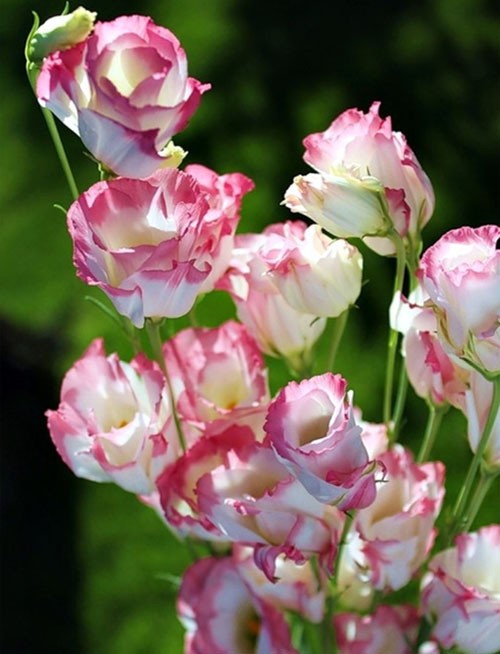 Complex mineral fertilizers are necessary for eustoma as a top dressing. You can bring them in half a month or a month after planting seedlings.
Complex mineral fertilizers are necessary for eustoma as a top dressing. You can bring them in half a month or a month after planting seedlings.
Seedling care
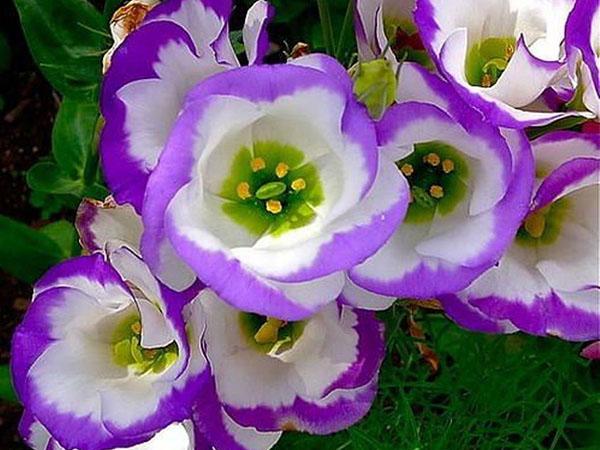 Seedlings grown from seeds are planted in a place where there is enough sunlight, but there is no baking sunlight. Perennial eustoma requires planting and care to take place without excessive soil moisture.
Seedlings grown from seeds are planted in a place where there is enough sunlight, but there is no baking sunlight. Perennial eustoma requires planting and care to take place without excessive soil moisture.
Very fragile roots do not tolerate both frequent replanting and excessive moisture. When the air temperature drops, watering is reduced.
Soil selection
 In order for the eustoma to grow and bloom well, it is necessary to withstand certain soil requirements.
In order for the eustoma to grow and bloom well, it is necessary to withstand certain soil requirements.
She must be:
- fertile, containing compost and mineral fertilizers;
- breathable - well-drained;
- loose;
- damp but not wet.
In terms of composition, a mixture of one part of peat and one part of humus or high-quality black soil is suitable for a flower. It is impossible to fill the soil, otherwise the roots of the perennial eustoma, as in the photo, may rot.
Temperature regime
The milder the conditions of detention, the better the flower will grow, and the more abundantly it will bloom. It is desirable that the daytime temperature is between 20 and 25 ºС. And at night - not lower than 15 ºС. If the eustoma is perennial, the planting and care of which is carried out with the winter indoors, suitable conditions must be created.
Low-growing varieties of eustoma for growing in an apartment.
- Fidelity - up to 20 cm high, a large number of white simple flowers arranged in a spiral on the peduncle;
- The little mermaid - 15 cm high, pink, simple flowers, 6 cm in diameter;
- Florida Pink - 20 cm high, flowers are simple pink, form an aligned bouquet.
.
- Growing lisianthus from seeds
- Growing catalpa from seeds
- Cabbage seed germination
- How to plant cabbage seeds correctly
- Preparing tomato seeds for planting
- Tomato seeds do not germinate
- Planting tomatoes seed preparation
- Growing greenhouse tomatoes
- Tomato seeds before planting
- Preparing tomato seeds for planting seedlings
- New varieties of tomato seeds
- Growing tomatoes in greenhouses
- Sowing tomato seeds
- Balcony tomato seeds
- Tomato seeds are the best varieties
- Tomato seedlings growing
Eustoma: home care. In detail
Bloom
Falls in the winter season: more often it is January-February. The flowering period lasts quite a long time, as the flowers appear gradually one after the other. To maintain a neat appearance, all dried flowers and leaves must be removed. After the end of flowering, a dormant period begins, which lasts a couple of months.
The previous regime of watering and feeding the eustoma resumes, soon after that new buds and fresh leaves appear. The appearance of blossoming flowers depends on the variety, they differ from each other in size, shape, color and duration of the flowering period.
Temperature regime
The optimum temperature for growing is 15-20 degrees. In this case, the flower will delight with buds every year, and if the air temperature is increased, flowering will be less frequent: once every two years. Low temperatures negatively affect the growth and development of the plant, there is a risk of disease due to cool conditions.
Spraying
Homemade eustoma does not need to be sprayed: this can cause various diseases due to high humidity.
Regular watering will be enough to provide the plant with moisture.
Lighting
For a pot with a plant, a southern window, which is well lit, is best suited. But direct sunlight should not fall on the flower, as this can dry out the leaves and flowers.
Eustoma at home requires a lot of light for the favorable course of the growth and reproduction processes, therefore, in winter, the pot with the plant must be illuminated for at least 12 hours with artificial light sources.
Eustoma pot
The ideal container for growing a Texas bell is a medium sized plastic pot, clay pots are best for growing other types of plants. The pot should be of such a height that a drainage layer can be safely put on the bottom (expanded clay or cut foam is suitable as a material for drainage).
Too large and deep pots should not be taken: in this case, the plant will not bloom for a very long time. Only after the root system grows and touches the walls of the pot does the flowering process begin.
Priming
Best suited as a soil for eustoma soil for growing violets... At the bottom of the pot, a drainage layer of expanded clay is necessarily created. The soil can be made independently: this requires mixing earth, humus and river sand in equal proportions.
A little lime can be added to the resulting mixture. The acidity of the soil should be neutral or slightly alkaline.
Acidified soil can lead to plant diseases, as zinc toxicity develops and plant development slows down.
Top dressing and fertilization
Caring for eustoma at home includes feeding for growth and flowering. For these purposes, liquid fertilizers are suitable, in which there is a sufficient amount of potassium. How to properly dilute the fertilizer is written on the instructions. On average, this is 10-15 grams per bucket of warm water.
Pruning
It is produced as the flowers and leaves dry up, as well as during the dormant period. It is recommended to remove all dried parts to maintain the decorative appearance of the indoor flower; they can also interfere with the growth of new shoots.
The indoor plant is pruned, while always leaving several shoots with internodes.
Dormant period
Begins after flowering is complete. The eustoma is cut off, and the pot is transferred to a cooler room with a temperature of no more than 15 degrees. During this period, the frequency of watering is reduced to 1 time in 3-4 weeks, and a break is also taken in the application of fertilizers.
Reproduction methods
For the reproduction of eustoma, gardeners most often use seeds, less often cuttings. The seed method of propagation of these flowering plants is considered the most effective.
Seeds
To obtain lisianthus seedlings from seeds, it is recommended to sow the seeds in February or March. Sowing of seeds is carried out in containers with a very loose soil mixture, consisting of peat soil and fragments of the bark of deciduous trees (1: 1). Suitable for sowing seeds and ready-made store substrate for growing seedlings.
Before sowing, the surface of the substrate is leveled and well moistened. Then seeds are spread on the moistened ground (seed material is recommended to be purchased in a coated form) at a distance of 2-3 centimeters from each other. The decomposed seeds are lightly pressed to the ground with a fingertip, after which the crops are sprayed with warm water from a spray bottle. Do not sprinkle the seeds with sand or earth.
Next, the container with crops is tightened with a transparent film, in which several small holes are made for better air circulation. Before the emergence of shoots, carefully monitor the level of moisture in the ground and air in an impromptu "greenhouse". The waiting time for the first shoots is 2-3 weeks. Before the emergence of seedlings, the container with crops must be periodically ventilated, occasionally spraying the substrate.
In the second half of March, the container with seedlings should be sent to a place with soft diffused light, protected from drafts. The air temperature in the room should be + 20-22 ° С. Strengthened seedlings are allowed to dive in 6-8 weeks, when 2-3 pairs of true leaves are formed.It is strongly discouraged to postpone the pick until a later date.
By cuttings
Some tall varieties of Lisianthus can be propagated by apical or intermediate cuttings. This procedure is usually carried out during the period when the plants are in the phase of active growth and budding. To obtain planting material, the strongest multi-stem eustoma bush is selected, from which a healthy, well-developed shoot is separated. This shoot is cut into pieces so that there are about 4-5 internodes on each cuttings.
Further, the lower leaves on the cuttings obtained are removed, and the upper ones are cut in half. Then the lower cut of each cutting is powdered with a root stimulator ("Kornevin") and placed in a glass of water for 6-8 hours. Root cuttings of lisianthus in plain water. If all the recommendations are followed, the first roots in cuttings appear after 2-3 weeks. After that, the rooted planting material can be planted in separate cups with loose soil.


